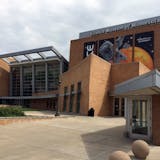From the Science Museum to the Minnesota Historical Society, the state's largest cultural institutions are seeking boosts in state funding as they slowly rebuild from revenue losses suffered during the COVID-19 pandemic.
As restaurants, movie theaters and some arts organizations try to rebound, recovery for cultural organizations here and nationwide is lagging behind due to rising costs, slumping donations and sluggish admissions.
"It's still a big challenge," Science Museum CEO Alison Rempel Brown said. "It's just not sustainable for an organization."
Unlike most nonprofits, many of the struggling cultural institutions receive significant state funding because they operate programs or draw visitors from across Minnesota.
The Minnesota Historical Society, which relies on state funding for about two-thirds of its revenue, will receive $23 million from the state this year. For next year, it has asked the Legislature for an additional $1.5 million and $2.5 million more for every year after that, arguing that state funding — which has risen annually by less than 1% in recent years — hasn't kept pace with inflation.
"Just to keep up, we need this funding," said David Kelliher, director of public policy and government relations at the Historical Society. "It's important that the state funds the work that we do and other history organizations ... so that all Minnesotans can learn about our past."
The Science Museum typically gets about $1 million a year from the state, amounting to about 5% of its revenue. But it hasn't seen an increase in its state appropriation in 10 years. This year, the museum has requested $3 million in Legacy Amendment and general funds.
Science Museum officials also hope to persuade legislators to tap the state's historic surplus for a one-time payment of $12.3 million to pay off the debt for its sprawling 1999 facility on the Mississippi River bluffs in downtown St. Paul. As with the proposal to pay off the publicly financed part of U.S. Bank Stadium's debt, Brown said, the state should step in to help the Science Museum and free up about $1.5 million a year for operations and other expenses.


